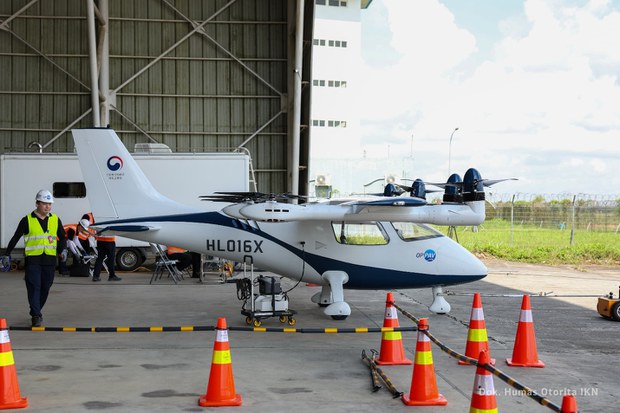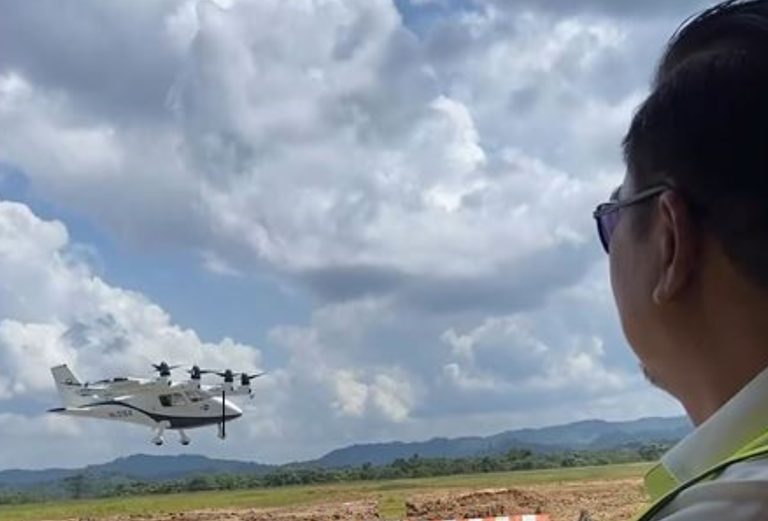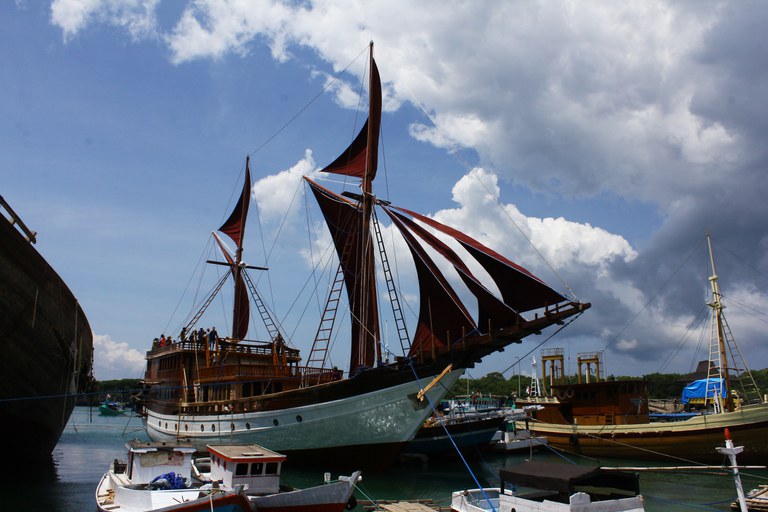Hoping for future takeoff, Indonesia’s new capital showcases ‘SkyTaxi’ test flight
2024.07.30
Samarinda, Indonesia
 An Advanced Air Mobility aircraft developed by Hyundai Motor Corp. and Korea Aerospace Research Institute (KARI) as an air taxi is seen at a hangar in Samarinda Airport in Indonesia’s East Kalimantan province, July 29, 2024.
An Advanced Air Mobility aircraft developed by Hyundai Motor Corp. and Korea Aerospace Research Institute (KARI) as an air taxi is seen at a hangar in Samarinda Airport in Indonesia’s East Kalimantan province, July 29, 2024.
Indonesian President Joko “Jokowi” Widodo’s grandiose project to build a new capital comes with an equally elevated transportation vision that includes flying taxis.
And officials said they successfully showcased a test flight of one such air taxi on Monday, Jokowi’s first day of work from the under-construction capital city Nusantara on Borneo island.
A prototype of a hybrid aircraft that can be operated both with or without a crew on board took a 10-minute flight from Samarinda Airport, near Nusantara in East Kalimantan province, the capital authority said.
The so-called SkyTaxi, as the Nusantara Authority calls it, is designed to carry four passengers and a pilot.
A joint effort between the Indonesian government and Hyundai Motor Group, the test craft flew at a speed of 50 kph (31 mph) and reached an altitude of 50 meters, Mohamed Ali Berawi, deputy for green and digital transformation at the Nusantara Capital Authority, told reporters.
“Our hope is that, together with Hyundai and Korea Aerospace Research Institute, we can develop the SkyTaxi technology for production and use in Indonesia, given the importance of environmentally friendly and effective transportation,” Berawi said.
The success of this test flight was proof of global companies’ interest and seriousness in participating in the development of Nusantara, he said.
“This advanced air mobility model is now being introduced in Nusantara. In the future, with related companies in Indonesia, we aim to further develop and utilize this urban air mobility technology,” he added.
Hyundai Motor Group plans to pursue research and development to commercialize the system by 2028 and expects the first air taxis to fly in the new capital by 2030, said Cheol-ung Kim, a business development officer at the Korean manufacturer.
“We will also forge strategic partnerships with the Indonesian government and institutions to lead the Advanced Air Mobility market in the future,” he said in a statement.

Meanwhile, hybrid aircraft technology is still in the early stages of development, said Wahyu Andrianto, a researcher on technological innovation, at the University of Indonesia Center for the Study of Governance and Administrative Reform.
“The current limitations of battery technology restrict both the payload capacity and the range of these vehicles,” he told BenarNews.
Payload refers to passenger capacity and range to the distance the vehicle is able to travel.
Besides, the global community is developing standardized regulations and safety protocols for flying taxis, according to Wahyu.
“The Indonesian government can play a crucial role in driving the development of these global standards,” he said.
Nusantara is a U.S. $32 billion endeavor that many consider Jokowi’s legacy project as he prepares to exit office in October after two terms.
Built from the ground up in East Kalimantan, this planned city is envisioned as a model of sustainability as its plan boasts green spaces, smart infrastructure and a commitment to renewable energy.
Officials said Nusantara, meaning “archipelago,” would represent a radical departure from the challenges plaguing Jakarta, the current capital, such as traffic congestion, flooding and pollution.
Only electric vehicles are to be allowed in the new city, Jokowi has said.
The project is however mired in problems.
Construction delays, land acquisition obstacles and a struggle to attract investment are among some of the issues faced by what some analysts allege is a project driven by Jokowi’s political ambitions and legacy concerns.
Trackless train
In addition to flying cars, Nusantara is set to debut another transportation mode – the Autonomous Rail Transit (ART) system. This trackless train, guided by sensors and magnets embedded in the road, is scheduled to begin trial operations on Aug. 5.
The trial period, running until December, will be free for passengers, with two Chinese companies providing the trains, also known as lidar (light detection and ranging) guided articulated buses, for the trial, Transportation Minister Budi Karya Sumadi said.
“The president [Jokowi] has been very eager to make the ART a mode of transportation within Nusantara since I first reported it to him,” he told reporters on Monday.
“I have informed the president that the rolling stock [railcars] is already in Balikpapan,” he said, referring to the city across the bay.
The ART, with a capacity of 324 passengers per two-car set, will operate at speeds of 40 to 70 kph (24.8 to 43.4 mph) along two routes in the city center, he said.

A little old world whimsy within the planned high-tech space in Nusantara will be in the form of tours on Pinisi boats starting Aug. 1.
These iconic wooden vessels, which ply all over Sulawesi, Komodo, Raja Ampat, Lombok and Bali, are recognized by UNESCO as intangible Indonesian cultural heritage.
They will offer scenic rides between Balikpapan and the new capital, showcasing the region’s natural beauty and cultural attractions.
To support this initiative, the transportation ministry said it would provide one Pinisi boat and urged more commercial operators to offer similar services in the future.
“The potential for tourism in the pristine waters is remarkable and should be maximized,” said Budi, the transportation minister.
“It’s essential to introduce Nusantara to a broader audience, especially given the stunning natural beauty of Balikpapan Bay.”
Pizaro Gozali Idrus in Jakarta contributed to this report.







